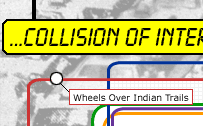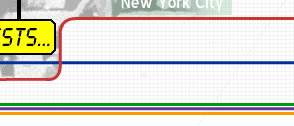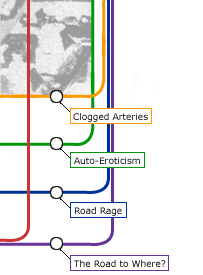



Situationist Theses on Traffic || The Social Ideology of the Motorcar || How Traffic Destroys the Eco-City || Excess
Killed by Automobile
Death in the Streets in New York City 1994-1997
by Charles Komanoff and Members of Right Of Way
Driver Culpability
The Responsibility of Drivers: When a car hits a pedestrian or cyclist, conventional wisdom blames the victim. Jaywalking is ingrained in New York culture -- it has been called the city "s secular religion -- and most cyclists treat red lights as stop signs at best. This rule-breaking is generally attributed to carelessness, if not insanity, and is regarded as the reason for most pedestrian and cyclist deaths.
Yet the police accident reports obtained for this study tell of pedestrians struck down by speeders and red-light runners, or even on sidewalks. At any intersection, motorists can be seen forcing their way through crosswalks or otherwise infringing on walkers " lawful right-of-way. This behavior impels pedestrians to bend the rules for the sake of self-protection. The chaotic character of traffic at intersections leads many pedestrians to conclude that crossing mid-block is safer, since one only has to look for cars coming in a single direction. Similarly, cyclists "slip through " red lights in order to gain one or two blocks " respite from threatening motorized traffic; cyclists who wait for the green often find themselves bullied from their lawful place on the road by impatient drivers.
If drivers, cyclists and pedestrians all flout the law, should they be held equally culpable in fatalities? No. Pedestrians and cyclists are not equivalent with drivers. Motor vehicle operators are licensed, their vehicles are registered, and insurance is required of them, precisely because of their potential for harm. By virtue of their weight and speed, motor vehicles are immensely dangerous machines, and the human body--even on a bicycle--is not.
Walkers don "t endanger drivers, except in rare instances where a driver must brake or swerve to avoid a pedestrian who has suddenly placed himself in harm "s way--and even in this case, the walker is at far graver risk than the driver.
In marked contrast, vehicles and drivers routinely endanger pedestrians, not only by violating their lawful right-of-way, but just by being there. Few things are more unsettling than having to push a baby stroller past a phalanx of cars at a red light, or maneuvering through a minefield of vehicles that have spilled into an intersection. Moreover, walkers and cyclists have no protective safety devices, except perhaps for a helmet. Indeed, to the extent that car seat belts and airbags heighten motorists " sense of their own invulnerability and encourage reckless driving, "auto safety " improvements arguably cause increased danger for non-motorists.
It is the presence of the car in the street picture that brings the danger; had the driver chosen to walk, cycle, or take the subway, he would have posed little or no danger to anyone. But the driver has chosen to drive, and must accept the responsibility that comes with this choice. Accordingly, Right Of Way frames crash culpability primarily in terms of driver action rather than that of the pedestrian or cyclist, though the pedestrian "s actions may be relevant to the collision and should be considered in any case. In this regard, we are adhering to the time-honored principle that the powerful are obligated to avoid harming the weak.
To understand the difference between our approach and the conventional one, consider two deaths, both from 1997. Dante Curry, age 6, was struck and killed on Wales Avenue, a predominantly residential street in the South Bronx, on the afternoon of October 2. According to the driver "s statement, included in the police report, Dante "ran out from [between] double-parked autos, causing operator of vehicle to strike him. " According to his family, Dante had been frightened by a dog and was running to his father, who was working across the street.
In the official narrative of Dante "s death, he appears as the only subject of a finite verb: he "ran out " and "caused " the vehicle to strike him. Yet the unusually candid driver acknowledged traveling at 65 mph. This is more than twice the 30 mph speed limit, and far faster than any pedestrian--child or adult--should need to anticipate on such a street. It was also too fast for the driver to react and stop. Indeed, had Dante journeyed to the end of the block and crossed at the (unsignalized) corner, as the law requires, the outcome would have been no different. By any sane standard, the responsibility for Dante "s death lies with the speeding driver, not the "jaywalking " six-year-old.
Six months earlier, on April 2, 30-year-old Jill Solomon was cycling down Second Avenue in Manhattan en route to work. As she was passing the 59th Street approach to the Queensboro Bridge, she came alongside an 80,000-pound tractor trailer. The police report states:
Witness states vehicle #1 [the truck] was southbound on 2nd Ave. and turning left onto bridge entrance ramp when bicyclist also south bound on 2nd Ave. struck left rear side of vehicle #1. Witness states bicyclist fell under truck "
In this narrative, Jill Solomon gets the only verbs that denote acts rather than states of being. She "struck " the truck and "fell " under its wheels. Behind this surreally twisted language is a clear picture: The truck turned left in front of Ms. Solomon and ran over her with its rear wheels (a "recurring " crash scenario; see sidebar, p. 57).Yet the computer "abstract " of this case compiled by the State Dept. of Motor Vehicles cited "Bike "s Error-Confusion " as the primary "apparent factor " in causing the crash, in effect blaming the lawfully proceeding cyclist. (The same document coded the driver "s "pre-accident action " as "going straight ahead, " contradicting the witness "s account.) Officially, Dante Curry was jaywalking. Jill Solomon violated no law, but was nevertheless written off as "confused. " In effect, both were pronounced guilty of their own deaths.
We take a different view: In both these cases, the driver egregiously failed in his duty to exercise caution commensurate with his power to harm. We regard the drivers as fully culpable in the deaths of Dante Curry and Jill Solomon.
Under this changed paradigm of responsibility, analysis of our data reveals that in 90% of cases where culpability could be ascertained, the driver was entirely or partially culpable, in the sense of having committed (or omitted) some action without the due care required of a driver, that contributed significantly or partially to the fatal crash.
Of 242 pedestrian and cyclist fatalities in 1997 for which we had accident reports, driver action conformed to cause codes 101 to 113 in 140 cases, indicating that the driver was largely or strictly culpable in 58 percent of all fatalities. This percentage becomes 74 percent when unknown cases are excluded. Drivers were partly culpable in 31 cases (13 percent of all cases, 16 percent of known cases). Combining this group with the highculpability group, drivers were at least somewhat culpable in 71 percent of all pedestrian and cyclist fatalities--90 percent excluding the unknown cases.
Driver culpability was ruled out in only 7 percent of all pedestrian and cyclist fatalities (10 percent when unknown cases are excluded).
Excluding 53 fatalities for which cause could not be determined, and setting aside hit-and-run incidents, more than half of the 1997 pedestrian and cyclist fatalities are attributable to six causes: Driver turned into ped in x-walk 33 17%
Speeding 21 11%
Drove through red light or stop sign 19 10%
Insuff. driver caution in ped area 19 10%
No pedestrian forewarn / driver r-o-w 15 8%
Driver struck pedestrian in crosswalk 14 7%
Percents are relative to 189 cases with known cause. Case numbers and percents reflect double-counting of cases with multiple cause (31 cases have two causes, 6 have three).
For policy purposes, it would seem obvious that the commonest sources of fatalities should be addressed before the more marginal ones. Existing policy turns this principle on its head. Drunken driving, for example, does not even appear on the list of the commonest causes,5 yet it receives an emphasis, in policy, which is not only disproportionate but positively pre-emptive of all other concerns. The only one of the common causes listed above that is ever mentioned in public discourse is speeding; and even for this well-known and well-understood variety of driver violence, actual enforcement (as opposed to hollow rhetoric) is extremely rare, at least in the nonhighway settings where pedestrian and cyclist fatalities occur.
Forty-nine of the 242 fatalities examined from 1997 were hitand- run; 18 of these were coded for other causes, such as driving on sidewalk or speeding, leaving 31 with no known cause. Although for reasons explained earlier we classified these fatalities as Driver Culpable, these cases--13 percent of all records from that year--constitute a large gap in our understanding of vehicle endangerment.
Pedestrian and Cyclist Fatalities Separated. Drivers " culpability "profile " differs between the 223 pedestrian and the 19 cyclist fatalities for our 1997 sample. Incomplete or inconclusive accident descriptions made it necessary to rate culpability as unknown in almost half of the cyclist fatalities, vs. one-fifth of pedestrian fatalities. The rate of unknowns for bicyclist fatalities is excessive, even allowing for the potential ambiguity in interpreting collisions on shared roadways. Many accident reports for cyclists were extremely perfunctory, lacking witness accounts or other efforts to reconstruct the events and determine cause. It is difficult to avoid the conclusion that investigating officers feel that a cyclist is "asking for it. "
Back to top